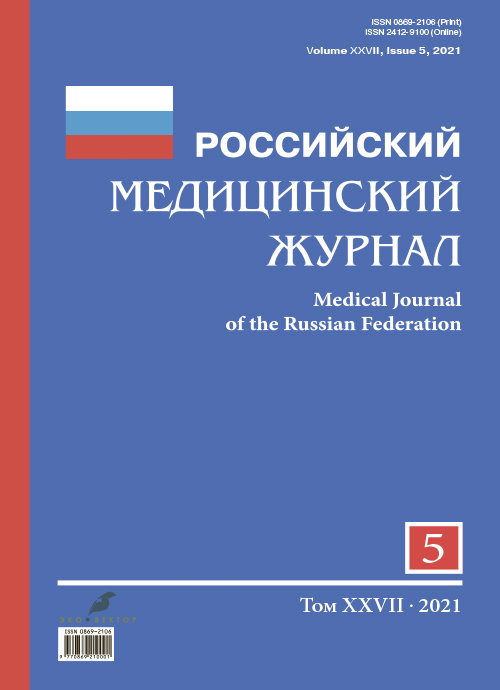Анализ морфологических изменений стенки желчного пузыря у пациентов после эндоскопического декомпрессионного вмешательства на желчных протоках
- Авторы: Шабунин А.В.1,2, Тавобилов М.М.1,2, Карпов А.А.1, Озерова Д.С.1,2
-
Учреждения:
- Городская клиническая больница им. С.П. Боткина
- Российская медицинская академия непрерывного профессионального образования
- Выпуск: Том 27, № 5 (2021)
- Страницы: 465-472
- Раздел: Клиническая медицина
- Статья получена: 11.10.2021
- Статья опубликована: 15.09.2021
- URL: https://medjrf.com/0869-2106/article/view/83030
- DOI: https://doi.org/10.17816/0869-2106-2021-27-5-465-472
- ID: 83030
Цитировать
Полный текст
Аннотация
Обоснование. Зачастую при выполнении лапароскопической холецистэктомии у пациентов, перенесших ретроградную эндоскопическую холедохолитоэкстракцию, возникают технические сложности, что связано с развитием деструктивных изменений в желчном пузыре. Однако в литературе на сегодняшний день отсутствуют исследования по оценке морфологических изменений, происходящих в стенке желчного пузыря на разных сроках после эндоскопического ретроградного вмешательства на желчных протоках. Актуальность темы и ее малоизученность побудили нас к проведению данного исследования.
Цель — определить оптимальные сроки выполнения лапароскопической холецистэктомии после эндоскопического декомпрессионного вмешательства на желчных протоках, выполняемого по поводу желчнокаменной болезни, осложненной холедохолитиазом, в зависимости от морфологических изменений, возникающих в стенке желчного пузыря.
Материалы и методы. Представлен сравнительный анализ патологоанатомического исследования 198 желчных пузырей, удаленных оперативным путем на разные сутки после эндоскопического декомпрессионного вмешательства на желчных протоках, выполняемого по поводу желчнокаменной болезни, осложненной холедохолитиазом.
Результаты. В 1-й группе холецистэктомия после эндоскопического декомпрессионного вмешательства на желчных протоках выполнялась на 1–3-е сутки. Изменения в стенки желчного пузыря были отмечены у 10 (12,8%) пациентов. Во 2-й группе холецистэктомия была выполнена на 4–7-е сутки. Изменения воспалительного характера были обнаружены в 13 (37,1%) препаратах. При патологоанатомическом исследовании операционного материала 3-й группы пациентов, которым холецистэктомию выполнили на 14–30-е сутки, изменения в стенке желчного пузыря были отмечены в 48 (56,4%) случаях.
Заключение. Наиболее оптимальным является выполнение лапароскопической холецистэктомии после эндоскопического декомпрессионного вмешательства на желчных протоках в течение первых 72 ч.
Полный текст
Об авторах
Алексей Васильевич Шабунин
Городская клиническая больница им. С.П. Боткина; Российская медицинская академия непрерывного профессионального образования
Email: info@botkinmoscow.ru
ORCID iD: 0000-0002-4230-8033
SPIN-код: 8917-7732
д.м.н., профессор, член-корр. РАН
Россия, 125284, Москва, 2-й Боткинский проезд, д. 5; МоскваМихаил Михайлович Тавобилов
Городская клиническая больница им. С.П. Боткина; Российская медицинская академия непрерывного профессионального образования
Email: botkintmm@yandex.ru
ORCID iD: 0000-0003-0335-1204
SPIN-код: 9554-5553
д.м.н., доцент
Россия, 125284, Москва, 2-й Боткинский проезд, д. 5; МоскваАлексей Андреевич Карпов
Городская клиническая больница им. С.П. Боткина
Email: botkin.karpov@yandex.ru
ORCID iD: 0000-0002-5142-1302
SPIN-код: 9877-4166
к.м.н.
Россия, 125284, Москва, 2-й Боткинский проезд, д. 5Дарья Сергеевна Озерова
Городская клиническая больница им. С.П. Боткина; Российская медицинская академия непрерывного профессионального образования
Автор, ответственный за переписку.
Email: ozerova311@yandex.ru
ORCID iD: 0000-0003-4996-5025
врач-хирург отделения экстренной хирургической помощи №75, очный аспирант кафедры хирургии Российской медицинской академии непрерывного профессионального образования
Россия, 125284, Москва, 2-й Боткинский проезд, д. 5; МоскваСписок литературы
- Aboulian A., Chan T., Yaghoubian A., et al. Early cholecystectomy safely decreases hospital stay in patients with mild gallstone pancreatitis: a randomized prospective study // Ann Surg. 2010. Vol. 251, N 4. P. 615–619. doi: 10.1097/SLA.0b013e3181c38f1f
- Bostanci E.B., Ercan M., Ozer I., et al. Timing of elective laparoscopic cholecystectomy after endoscopic retrograde cholangiopancreaticography with sphincterotomy: a prospective observational study of 308 patients // Langenbecks Arch Surg. 2010. Vol. 395, N 6. P. 661–666. doi: 10.1007/s00423-010-0653-y
- Pardo A., Selman M. Matrix metalloproteases in aberrant fibrotic tissue remodeling // Proc Am Thorac Soc. 2006. Vol. 3, N 4. P. 383–388. doi: 10.1513/pats.200601-012TK
- Gorla. Optimal Timing of Laparoscopic Cholecystectomy after Endoscopic Retrograde Cholangiopancreatography // J Curr Surg. 2014. Vol. 4, N 2. P. 35–39. N. P. doi: 10.14740/jcs230w
- Ercan M., Bostanci E.B., Teke Z., et al. Predictive factors for conversion to open surgery in patients undergoing elective laparoscopic cholecystectomy // J Laparoendosc Adv Surg Tech A. 2010. Vol. 20, N 5. P. 427–434. doi: 10.1089/lap.2009.0457
- Verhofstad M.H., Lange W.P., van der Laak J.A., et al. Microscopic analysis of anastomotic healing in the intestine of normal and diabetic rats // Dis Colon Rectum. 2001. Vol. 44, N 3. P. 423–431. doi: 10.1007/BF02234744
- Ghnnam W.M. Early Versus Delayed Laparoscopic Cholecystectomy Post Endoscopic Retrograde Cholangio Pancreatography (ERCP) // JSM Gen Surg Cases Images. 2016; N 1. P. 1006.
- Salman B., Yilmaz U., Kerem M., et al. The timing of laparoscopic cholecystectomy after endoscopic retrograde cholangiopancreaticography in cholelithiasis coexisting with choledocholithiasis // J Hepatobiliary Pancreat Surg. 2009. Vol. 16, N 6. P. 832–836. doi: 10.1007/s00534-009-0169-4
- Sahu D., Mathew M.J., Reddy P.K. Outcome in Patients Undergoing Laparoscopic Cholecystectomy Following ERCP; Does Timing of Surgery Really Matter? // J Minim Invasive Surg Sci. 2015. Vol 4. P. e25226.
- Coppola R., Riccioni M.E., Ciletti S., et al. Analysis of complications of endoscopic sphincterotomy for biliary stones in a consecutive series of 546 patients // Surg Endosc. 1997. Vol. 11, N 2. P. 129–132. doi: 10.1007/s004649900314
- Costi R., DiMauro D., Mazzeo A., et al. Routine laparoscopic cholecystectomy after endoscopic sphincterotomy for choledocholithiasis in octogenarians: is it worth the risk? // Surg Endosc. 2007. Vol. 21, N 1. P. 41–47. doi: 10.1007/s00464-006-0169-2
- Wynn T.A. Common and unique mechanisms regulate fibrosis in various fibroproliferative diseases // J Clin Invest. 2007. Vol. 117, N 3. P. 524–529. doi: 10.1172/JCI31487
- Tomasek J.J., Gabbiani G., Hinz B., et al. Myofibroblasts and mechano-regulation of connective tissue remodelling // Nat Rev Mol Cell Biol. 2002. Vol. 3, N 5. P. 349–363. doi: 10.1038/nrm809
Дополнительные файлы










